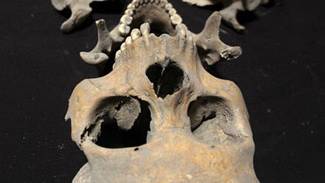Ancient Tomb Found in Mexico Reveals Mass Child Sacrifice
Source: news.nationalgeographic.com
 The skeletons of two dozen children killed in an ancient mass sacrifice have been found in a tomb at a construction site in Mexico.
The skeletons of two dozen children killed in an ancient mass sacrifice have been found in a tomb at a construction site in Mexico.The find reveals new details about the ancient Toltec civilization and adds to an ongoing debate over ritualistic killing in historic Mesoamerica.
Construction crews unearthed the burial chamber this spring near the town of Tula, the ancient Toltec capital, 50 miles (80 kilometers) north of Mexico City (see Mexico map).
The chamber contained 24 skeletons of children believed to have been sacrificed between A.D. 950 and 1150, according to Luis Gamboa, an archaeologist at Mexico's National Institute of Anthropology and History.
All but one of the children were between 5 to 15 years of age, and they were likely killed as an offering to the Toltec rain god Tlaloc, Gamboa said.
The Toltec, a pre-Aztec civilization that thrived from the 10th to 12th centuries, had not been previously thought to have sacrificed children.
But the ritualistic placement of the skeletons, cut marks on bones, and the presence of a figurine of Tlaloc led Gamboa to conclude the children had been sacrificed to bring rain.
"To try and explain why there are 24 bodies grouped in the same place, well, the only way is to think that there was a human sacrifice," Gamboa told the Reuters news agency.
"You can see evidence of incisions, which make us think they possibly used sharp-edged instruments to decapitate them."
Elaborate Burials
The skeletons were each found in a seated position looking east to face the sunrise, Gamboa said.
Several artifacts were also found around the bodies, some of which suggest that the children had been brought in from another region, he added.
"We believe that based on the comparison of archaeological materials that accompanied the human burials," Gamboa told National Geographic News.
In particular, he said, his team discovered some vessels that bore markings "similar to those found in the southern region of the Basin of Mexico."
Two of the children also appear to have been given especially elaborate burials, based on the quality of vessels and other artifacts found nearby, including turquoise that may have originated in the present-day southwestern United States.
Gamboa's discovery requires some important changes to the time line of Mesoamerican history, said Traci Ardren, an archaeologist at University of Miami who was not involved in the research.
"This new discovery at Tula pushes back the evidence for a relationship between child sacrifice and the [appeasement] of the rain god Tlaloc at least 300 years," she said.
Evidence suggests the children sacrificed to Tlaloc were in very poor health when they died and that the sacrifices were not punitive, she added.
Children of "young age and greater purity" were "more powerful mechanisms for the petitions of the living," Ardren said.
Signs of sacrifice are not unique at this time and place, noted Robert Carmack, an anthropologist at the University of Albany, but Gamboa's findings demonstrate the influence that the Toltec had in the region.
"[Cultures during this] period in Central Mexico, especially the Aztecs, were profoundly influenced by the Toltecs, so the existence of Toltec child sacrifice is not at all surprising," he said.
Carmack said early Toltec influence was also pervasive in the highlands of what is now Guatemala, and Maya documents from the region refer to child sacrifice.
(See a video about Maya violence in the movie Apocalypto.)
"There is sound evidence of the existence of child sacrifice there, although perhaps not on a grand scale," he said.
Article from: http://news.nationalgeographic.com/news/
2007/06/070612-tomb-child_2.html






















